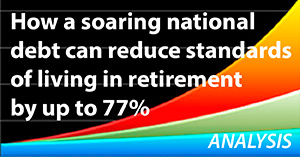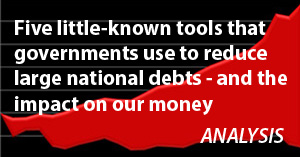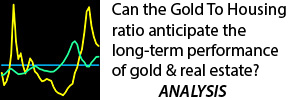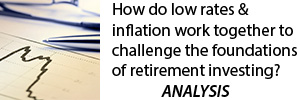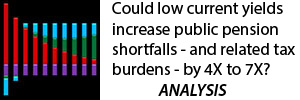The Lessons From Puerto Rico's $73 Billion Bankruptcy
By Daniel R. Amerman, CFA
TweetThe United States territory of Puerto Rico has recently sought a form of bankruptcy relief from its creditors. Puerto Rico has reached the place where it owes about $73 billion in government debt, and it simply can't pay anymore.
There are about 3.5 million people in the Commonwealth of Puerto Rico, so that means there is an average debt outstanding of about $20,000 for every man, woman and child who lives there. People usually don't think about government debt in per capita terms but when we do think about it - does it seem reasonable to believe that this debt could have ever been repaid?
Puerto Rico is a beautiful place and I have very much enjoyed the times I've been there. But for those of you who have spent time on the island - would you ever thought that it was reasonable for an average family of four to be able to come up with an extra $80,000 for their share of their government's debts?
The Impact On A Severely Underfunded Retirement System
And unfortunately this problem of $73 billion in debt from which Puerto Rico is seeking relief, is not a problem that exists in isolation. Puerto Rico also has a severely underfunded retirement system.
Per the Wall Street Journal, the government sponsored retirement system is underfunded by $45 billion. Now this raises a question: if Puerto Rico is defaulting on $73 billion in government bonds - then where can they possibly get the money to deal with $45 billion in unfunded pension obligations?
What really matters here - and there are much broader implications outside of Puerto Rico - is that the usual norm is to treat total government debts and total unfunded government retirement promises as two quite different things. Until they aren't.
We saw a smaller scale version of this in the United States in the bankruptcy of Detroit, where it turned out that the money that the city owed and the financial state of the retirement system were indeed closely interlinked. Where the inability to pay large amounts of debt also led to an inability to pay retirement promises in full.
A Healthcare System That Is Crashing
There is also another major crisis that is rapidly getting worse in Puerto Rico and that has to do with the health care system. It has been crashing for some time now, and has recently been getting much worse. A lack of funding, power shortages and a flight of medical professionals from the island are combining to create a health care crisis.
On a fundamental basis, Puerto Rico simply doesn't have the money to pay for its medical system because it doesn't have the money left over after not being able to make payments on the debt it owes, let alone after also paying for unfunded retirement promises.
Everything Looked Like It Was Separate - Until It Wasn’t
Again, there was the norm that was true in Puerto Rico and it is currently true for the United States and other nations. The norm is to treat government paid medical benefits as somehow being entirely separate from huge and growing government debts, with each of those also being entirely separate from massive unfunded government retirement promises. They are treated as being three separate baskets. And this may look like it is true – until it clearly isn't.
Because what it really comes down to is that when there's a limited amount of cash available, then the money can be spent paying creditors what has been contractually promised, or it can go to paying retirement promises, or it can go to hospitals and doctors - but the same dollar can't go all three places. There is only one basket, and there has always been only one basket, when it comes to paying for everything.
What triggered the merger of these three problems is a crisis.
The problems had been building in each area for years but as soon as government debt went critical - it reached out and pulled in the other areas. As explored in the Wall Street Journal article linked here, they became one thoroughly intertwined crisis.
Private Economy Is Imploding, Which Means Local Investments Are In Deep Trouble
There's another issue and that is the private economy. As one might expect the local economy is imploding and local investments are in deep trouble.
This is a major issue for anyone who has anything invested in the Puerto Rican economy. It could be bonds. It could be owning a business. It could be owning stock in a business. It could be real estate.
The economy is imploding, and simultaneous government issues with debt outstanding, unfunded retirement promises, and unaffordable health care spending have helped to create an island wide recession which could very easily become a true and lasting depression.
Unfortunately, this can create a feedback loop, where economic problems reduce tax revenues, which increase government shortfalls, which then increase the difficulties with paying for debts, retirement benefits and health care, which can then increase the problems for the economy and investors.
Now, the idea behind private wealth (among other reasons) is to have additional security beyond relying upon the government as a safety net.
So if problems occur with a retirement system or healthcare, then we can turn to our investments and savings which are supposed to have predictable rates of return that have nothing to do with government debts, retirement promises or healthcare.
The norm is to treat investments as existing in what is almost an entirely different world than those problem areas.
Our Financial Future Is Holistic
Yet what Puerto Rico is demonstrating in real time and in great detail is that the financial world is in fact holistic. In practice, government debts and unfunded retirement promises and rising medical costs do in fact quite directly impact and even dominate investment returns.
With 20/20 hindsight and looking at what's going on in Puerto Rico right now - this may seem easy to see.
How could anyone possibly be so blind as to not see that soaring government debts would make unfunded government retirement promises impossible to pay?
How could anyone not see the obvious connection with the ability to pay for health care?
How could an intelligent person possibly rationalize buying stocks or bonds from a business in Puerto Rico, or real estate on the island, without taking into account the issues with government debt, retirement promises and health care?
The world is, however, an interesting place. Widespread perceptions and social belief systems about investing may be based on quite thin ice, rather than the rock-solid foundations that the public usually assumes.
The United States as a whole is not Puerto Rico. It is far larger, it is far wealthier, and it is a sovereign nation which controls its own laws and monetary system. So, the parallels are not exact, and the United States can do things - and has been doing things - that its territory cannot.
But that said, the United States has a government debt problem that dwarfs that of Puerto Rico, whether we look at the debt on a total basis, or a per capita basis.
Unfunded retirement liabilities of $45 billion could be called a "rounding error" when compared to the staggering unfunded liabilities of Social Security and state and local pensions. Future financial issues with Medicare in particular and the health system in general are exponentially larger than what Puerto Rico is currently experiencing.
As explored in the detailed numerical analysis linked here, we know that the three issues are tightly financially interlinked for the United States, and that the combined problems will soar over the next ten years.
Now some might say that Puerto Rico is not a good comparison because it has been a developing financial train wreck for years now, and the markets have been staying away. But that perspective misses the point.
As recently as 2014, Puerto Rico was as in debt as it is right now, it had huge unfunded pension liabilities, and it had major problems paying for health care. The components of today's crisis were all there and had been building for years in plain sight.
But nonetheless, Puerto Rico general obligation bonds were still trading at 100 cents on the dollar. Because the markets were not only following the norm of treating those as being three separate baskets - but were also completely ignoring any connections with investment strategies and results.
That approach hasn't worked out so well for investors and landowners in Puerto Rico, and the problems with it seem blindingly obvious in 2017.
Could the time be coming in the years ahead, when savers and investors in the United States come to a similar realization about what they should have obviously been taking into consideration when making financial decisions about the future?
Puerto Rico was about averting the eyes and refusing to connect the dots – until the dots were connected for all of us. We will have our eyes wide open and will be identifying many risks and many potential opportunities as we thoroughly connect the dots for the United States at the upcoming "Disruption & Wealth" workshop in the Chicago area in June.




